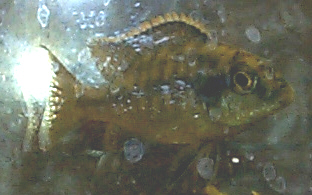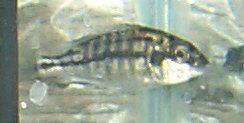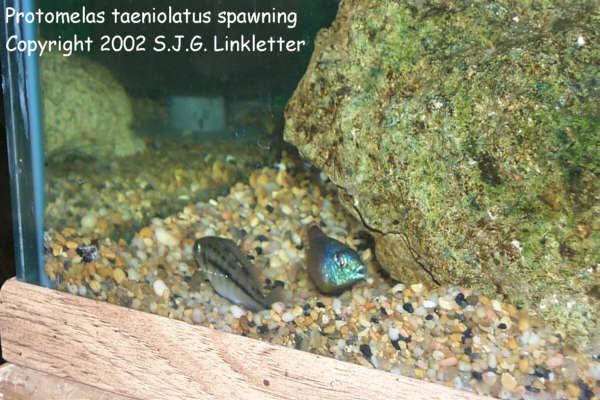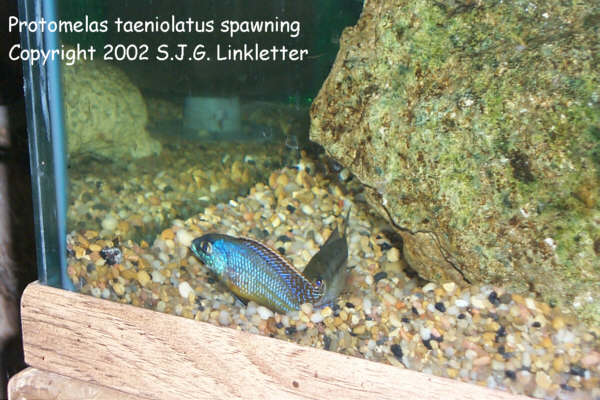
| The
Burrow Main Menu |
| Slink's Tropical Fish |
January 2002
This was my first try at building the reef in my 75-gallon, for African Rift Lake cichlids. Feedback from a forum online convinced me that I had too much rock in the tank, so I rebuilt the reef from the bottom up.

And here it is after I rebuilt the reef. I'm not really sure that this will be better for the kind of fish that I am going to keep because they like rocks to hide in, but I agree that there wasn't much room to swim in the tank above. I only hope that three species of mbuna can live together in these rocks.

Eventually I decided against three species of mbuna and opted for one haplochromine from Lake Victoria with two mbuna from Lake Malawi. I finished equipping and decorating the tank. The plants are mostly hornwort, with a few African ferns.

And here's the new darlings. The cichlids are mostly 1.25", with a couple only 1" and some almost 1.5". The yellow ones are the Pseudotropheus sp. "Magunga Deep". The striped ones are the Pundamilia nyererei "Makobe Island". The blotchy one near the bottom left is a Labeotropheus fuelleborni "Marmalade Cat".

The catfish are really tiny right now, only about 1" maximum from tip of nose to end of tail. They are exact miniatures of the adults.

I bought 6 of each of the cichlids and 3 of the catfish. In this way I hope to get a trio (one male and two females) of each of the kinds of cichlids.
April 2002
Here you can see that the luxuriant growth of hornwort shown above had been decimated. I do not know what the problem was, but the hornwort that I bought mail order just kept dying off. There was a small amount of growth but nothing like what I recall from my childhood tanks. I finally removed it entirely from this tank, and eventually relegated it completely to my new 20-gallon-high plant tank because I got tired of picking the dead leaves off the filter intakes every morning. The flower pots were added to provide shelter for holding females, or for the Synodontis, but the only thing that used them were snails who laid eggs inside them in record quantities. I removed the pots after a month. A bout of hexamita carried off two of my Labeotropheus before I located the proper medication. I netted them out and cared for them as best I could while trying to acquire the medicine, but they died anyway.



The Pundamilia nyererei began breeding, and one was killed. I thought this was probably a subdominant male, but the man who sold them to me said it was probably an egg-bound female. The death was very sudden, and there were no marks on the body. Of the remaining four "females", three have laid eggs but only one has done so with the dominant male. Two others have spawned with other females and one or both has eaten the eggs. The fourth may actually be another male but if so he does not perform as such. These fish were incredibly territorial in the 75-gallon tank. At the worst point the dominant Pundamilia male held three-quarters of the four-foot tank in conjunction with one of the Ps. sp. "Deep Magunga" males, and the remaining 13 fish lived in the other one-quarter of the tank. After I removed them the tank once again became evenly populated. I conclude that Lake Victoria haps are not temperamentally suited to sharing a tank with Lake Malawi mbuna. Oddly enough, in the 135-gallon tank to which I moved them the Pundamilia now spend a lot of time virtually schooling when previously they had all fought each other for territory. Evidentially all parties were dissatisfied with the previous arrangement.
May 2002




Shortly after these pictures were taken I tore the tank apart, moved the Pundamilia to the 135-gallon tank and added the Red Empress shown below. This was just the first of approximately four rearrangements that I perpetrated on the poor fish in this tank, with the result that they are not nearly as friendly and trusting as they had been. I assume they will regain trust with time. I am pretty much done rearranging things, although I may add some more rocks as I make them.
Red Empress, bought locally, one known male and three hoped-for females which turned out to be one dominant male, two females, and one dead subordinate male even before I got the fish out of quarantine.
Young male.

One of the young females.

Not too long after having been moved to the 75-gallon tank from their 30-gallon quarantine quarters the now resplendent male spawned with the larger female. Evidentially we did not agree on "young" in their case, which is why the subdominant male got killed when I thought there was plenty of time to arrange other housing. All of these fish continue to surprise me with their precocity.


The male dug a spawning pit in the gravel, and I was concerned that my plan to convert the bottom to ceramic tile might put him off his stride. Not a chance. In June the larger female was holding again. (The earlier batch vanished during a tank rearrangement.)
June 2002
June was the month of gravel-to-tile and higher-and-more-rockwork rearrangements. The conversion to tile from gravel worked great but my cleverly designed corner protector for the sponge filter did not perform well. It was held together only by fishing line, and did not have enough rigidity to support the other rocks without sliding around itself.


The solution was to remove the two-part corner protector, cement it together with silicone cement, and replace it in the tank. Because it had slipped during the previous rock arranging session all of the rocks adjoining had to be removed. I used the occasion to net out one last Pundamilia juvenile which I had spotted earlier but lacked the energy to deal with. This should now be the permanant basis for the tank's rockwork. I may add more rocks on the ends, and perhaps a few right up the middle as a visual divider between the endmost territories, but the fish need not fear another complete upheaval. I'm hoping they learn that eventually, because the apparently empty tank in the first picture below is how I am greeted nowadays after three complete teardowns of their tank in less than two months.

But throw in some food and there are fish here after all.

The two Ps. sp. "Deep Magunga", having sorted themselves out yet again, are back to a nice shade of blue. Visible here are two of the seven Labidochromis sp. "Perlmutt" that I added when the tiles were put in place. One or two of the females are already holding, one at the incredibly small size of 1". I find the vertically striped females and subdominant males more attractive than the dominant male. I hope he will become more attractive as he grows larger. Right now he is better described as grey than as mother-of-pearl (the source of the name Perlmutt).

Red Empress female holding, proof that the ceramic tile didn't throw the male Red Empress off his stride.

The Synodontis petricola are now roughly twice the length they were when I bought them. I added the two largest of my new batch of Synodontis, bringing the total in this tank up to 5.
